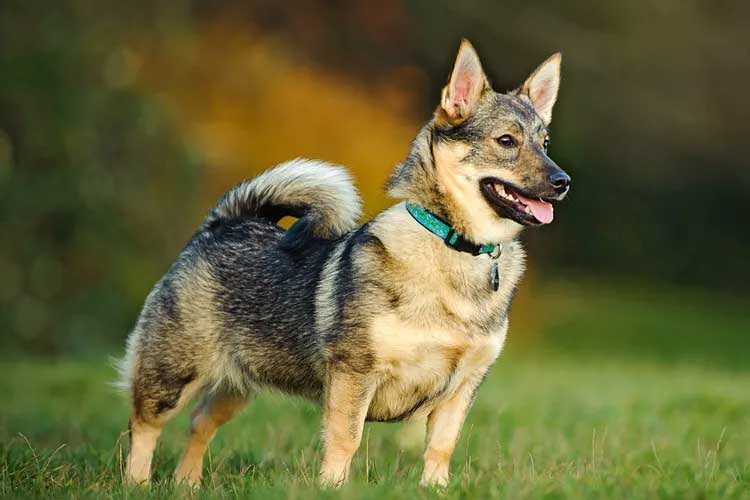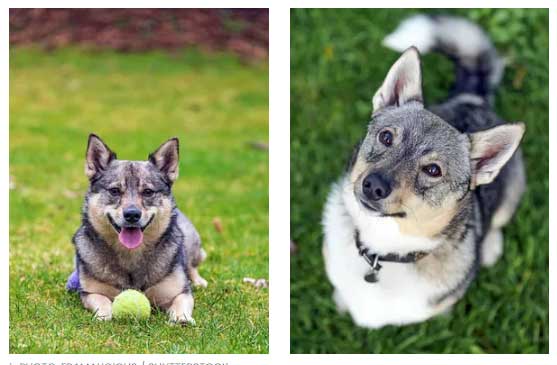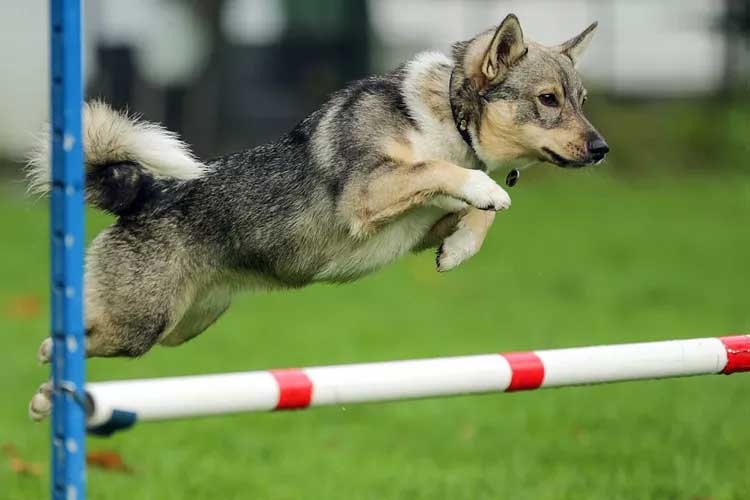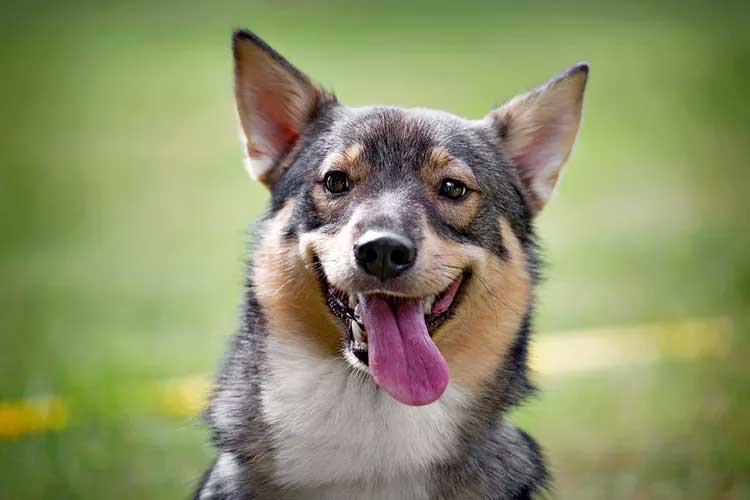
Swedish Vallhund Overview
| OFFICIAL NAME | Swedish Vallhund |
| COMMON NAME | Swedish Vallhund |
| PET HEIGHT | 11 to 13 inches |
| PET WEIGHT | 28 to 35 pounds |
| LIFESPAN | 12 to 15 years |
| GOOD WITH | cats, children, dogs, families, seniors |
| TEMPERAMENT | friendly, outgoing, playful, willful |
| INTELLIGENCE | high |
| SHEDDING AMOUNT | seasonal |
| EXERCISE NEEDS | high |
| ENERGY LEVEL | active |
| VOCAL LEVEL | frequent |
| DROOL AMOUNT | low |
| BREED GROUP | herding |
| BREED SIZE | medium (26-60 lbs.) |
| COAT LENGTH | medium |
| COLORS | black, blue, gold / yellow, gray, red, white |
| PATTERNS | sable |
| OTHER TRAITS | apartment-friendly, cold weather tolerant, easy to groom, easy to train, good hiking companion, hot weather tolerant, strong loyalty tendencies |
Swift and smart, the charismatic Swedish vallhund—also referred to as SV—has an ancient lineage that dates back to the time of the Vikings. But if his name isn't familiar, it's because he's only been in the U.S. for about 50 years and remains a rare breed.
The vallhund, which is Swedish for shepherd dog, is a lively and confident companion. Within an active family, he'll thrive while learning tricks; participating in agility, flyball, and other dog sports; and deciphering any puzzle toy you have on hand (better stock up!). When the day is done, he'll like nothing better than nestling up next to his favorite humans for plenty of pats and a treat or two.
Appearance
If you blink fast, you might think you've spotted some type of corgi impersonator when a handsome SV struts by. A full-grown Swedish vallhund is low to the ground—about 11–13 inches tall—with perky, pointed ears and a long muzzle, and this cattle-herder bears a strong resemblance to a Pembroke Welsh corgi or a Cardigan Welsh corgi.
Noting the differences between Swedish vallhunds and corgis requires more than a quick glance as these dogs are distant cousins. According to the Swedish Vallhund Club of America (SVCA), in the 8th or 9th centuries a rather sketchy family tree suggests either the vallhund—whose ancestors are Scandinavian spitz dogs—visited Wales or the corgis took a trip to Sweden, where they intermingled.
This is why these herding breeds share certain physical characteristics. While their weights are similar, with vallhunds averaging 28–33 pounds, they're not quite as stocky as corgis and have longer legs.
Some people covet a corgi butt, and SVs have a little snazzy hindquarter action of their own! Pam Abrath is the Swedish vallhund rescue committee chairperson for the SVCA and former co-breeder at Fantasi Swedish Vallhunds in Wisconsin. She outlines the various natural tail options these pups have from birth—even within the same litter.
"They can have anything from no tail [bob] or stub tail to full tails with variations of length," she says. "Full tails can be a tight-curled spitz tail or a saber tail. It's a unique feature of our breed."
A Swedish vallhund's double coat, thick to withstand the elements, is short and tri-colored, featuring various shades of black, blue, gray, gold, or white, usually in a sable pattern. His dark brown oval eyes are rimmed with black, enhancing a cheerful yet alert expression.
Temperament
From the moment they can waddle about on their wee legs, Swedish vallhund puppies are full of vigor! Rambunctious, eager to work and play, and inquisitive about the world around them, they're an excellent choice for an active pet parent who wants a lot of engagement with their furry friend."They're a versatile, athletic breed good at herding, agility, obedience, rally, nose work, barn hunt, and other fun activities," Abrath says. "They need to be kept busy or [they] can get into trouble doing things that they should not." Any form of positive reinforcement training that allows an SV to show off his abilities will result in endless tail-wagging.
If you're not in need of an independent and trusty four-legged farmhand, keep in mind that a Swedish vallhund dog lives his best life if he's mentally and physically engaged daily. This means using puzzles, games, and interactive toys to stimulate strategic thinking, plus various types of exercise to expend his boisterous energy. They're good hiking buddies, too, and might even enjoy a dip in the water now and then.
A Swedish vallhund's overall temperament is friendly and sweet-natured with an impish sense of humor. Abrath says they're also happy to wear the "Velcro dog" label, sticking close to their owners and wanting to be involved in all they do.

As natural herders and historic guardians of their people and animal flocks, they also keep a watchful eye on their environment. Puppy kindergarten and early socialization help your Swedish vallhund puppy keep an even keel as he matures.
Because they're so attentive and loyal, Swedish vallhunds are often therapy dogs. In fact, an SV named Moose, who competed in the 2011 Westminster Kennel Club event, detected an oncoming stroke in his owner's mother. Now there's a good dog!
Living Needs
Abrath says Swedish vallhunds tend to be quite vocal. "Some like to talk, and when you say something to them they will answer you—but they do have a lot to say at other times as well!"So if you're considering a cuddly apartment dog, a vallhund might be comfortable in that environment as long as he respects "quiet" cues when necessary and has nice open green spaces to dash around in each day.
Because SVs desire a lot of quality time with their owners, Abrath says, they can adapt to most living conditions and types of homes if they get enough exercise and mental stimulation. But it's best if he's in a fenced area wherever he's let off-leash, otherwise you might be surprised how fast—and far!—he can bolt.

It's no surprise if he tries to round up all the other pups at the dog park, too. Swedish vallhunds' natural herding instinct to put creatures in order might first be perceived as bossy, but when trained and socialized well, they're actually quite compatible with other dogs, live well with cats, and make great companions for children. Active seniors might also appreciate how the SV entertains them with their sporting abilities, while still making time for couch snuggles at the end of a busy day.
Trekking with the Vikings in a durable double coat means these rugged pups can handle the great outdoors. Abrath says SVs do well in hot, warm, or cold climates but, again, expect to be with their humans most of the time. So don't leave them in the doghouse too long by themselves—especially in extreme temperatures. If you're uncomfortable staying outside, they are too.
Care
Double-coated dogs including Swedish vallhunds benefit from a good brushing down to the skin once a week or so to keep shedding to a minimum. But batten down the hatches when coat blowing season starts because that's when the fur will really fly! Fortunately, this only happens in the spring and fall.You won't have to bathe your vallhund too often, unless he rolls in something icky. But when he's blowing coat, a lukewarm bath with a gentle doggie shampoo, followed by a light blow-dry and brushing, might minimize what fluff lands on your dining table.
Otherwise, your hardy vallhund is rather low-maintenance. Keep his chompers spiffy with regular tooth brushing, clean his ears, and trim his nails when needed, and you'll both get a treat at the next veterinary checkup.
Health
A robust pup with a lifespan of 12–15 years, Swedish vallhunds are, for the most part, a healthy breed with few concerns."The most common health issue in the breed is SV retinopathy/PRA [progressive retinal atrophy] found in our breed only to date," Abrath says. "Affected dogs rarely have any vision loss until later in life."
According to VCA Hospitals, retinopathy/PRA is a degenerative disease of the retina's photoreceptor cells. The condition is inheritable, so talk with a Swedish vallhund breeder first to learn what type of ophthalmologist evaluations they do and get an SV retinopathy DNA test. Because vallhunds aren't as common in the U.S. as they are in Europe, make sure you're choosing a reputable breeder.
Other Swedish vallhund health problems might include hip dysplasia, a frequent problem for spry herding breeds, defined by the American College of Veterinary Surgeons as "begins in dogs as they grow and results in instability or a loose fit (laxity) of the hip joint. The hip joint laxity is responsible for potential clinical signs (symptoms) of hip pain and limb dysfunction and progressive joint changes."
Abrath says health conditions experienced by a small number of SVs might include epilepsy, cardiac issues, autoimmune issues, and both food and environmental allergies.
History
The true origins of the Swedish vallhund are tangled up in Viking lore—in fact, according to the SVCA, they were once known as Vikingarnas hunds, or "Viking dogs." And of course, the aforementioned "who came first" family tussle with the corgis confuses the ancestral tree even more.But breed historians believe the early connection to the Vikings more than 1,000 years ago indicates vallhunds preceded corgis. Traveling across the Nordic seas and shepherding on vast tracts of land, these brave and spunky companions were always by their warriors' sides and often buried with them.
Valued for their cattle herding abilities, the SVCA states that in addition to being one of Sweden's national dog breeds, the country declared the vallhund as a Lantras: "a designation which includes the exhibition of qualities such as long life, patience to hardship, and hardiness."

So it's surprising that in the beginning of the 20th century, their numbers dwindled—to a point of near extinction by the early 1940s.
Breeder Count Björn von Rosen, who dedicated considerable time and resources to revive other prized Swedish breeds, approached another breeder, K. G. Zettersten, to see if they could save the Svenska vallhund. Within 20 years, the SV was once again thriving in his native land and recognized by various breed clubs in Europe.
In the mid-1980s, Marilyn Thell, who was of Swedish ancestry, started the first SV breeding program in the U.S. at Jonricker Kennel in Rhode Island. But only in 2007 was the breed recognized by the American Kennel Club.
Fun Facts
Swedish vallhunds are popular postage models, highlighted not only on stamps in Sweden, but also in Mali, Nicaragua, Russia, Tajikistan, and Ukraine.Other monikers for Swedish vallhunds include Västgötaspets (his official name in Swedish) and Swedish cattle dog.
The breed is the star of a 2014 Swedish documentary: Swedish Vallhund: A Big Dog in a Small Body.